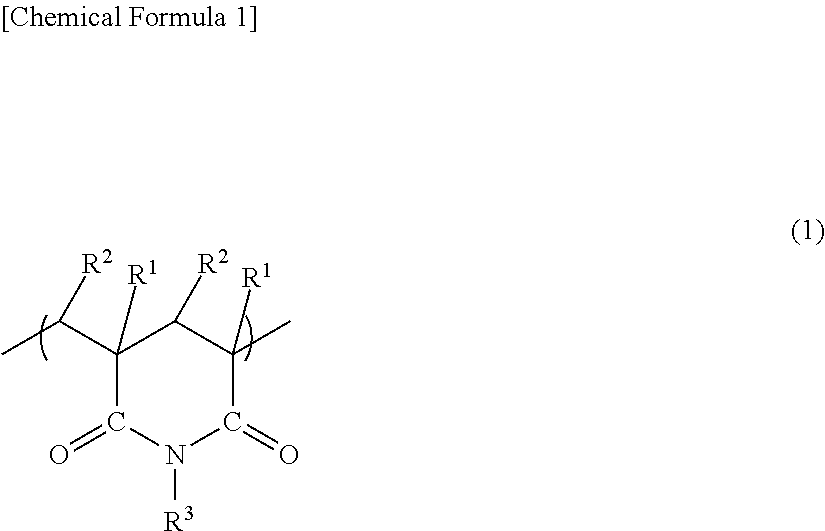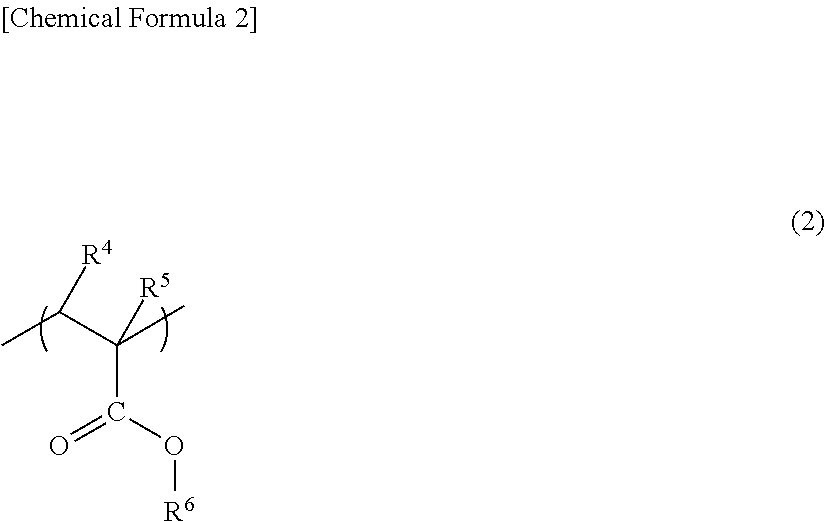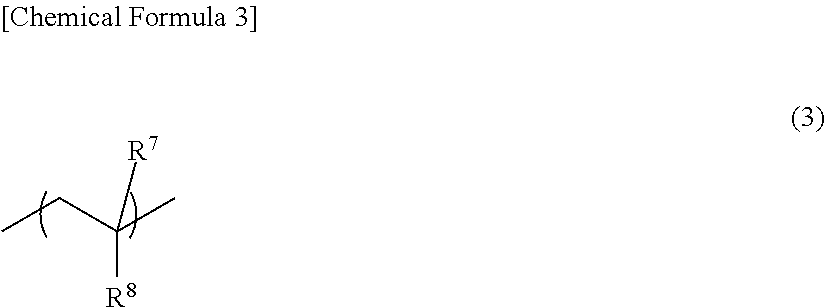Acrylic resin film
a technology of acrylic resin and film, applied in the field of acrylic resin film, can solve the problems of resin's significant impairment of weather resistance, resin's mechanical strength is not always sufficient, and its transparency is impaired, and achieves excellent heat resistance, flexibility, and excellent appearance.
- Summary
- Abstract
- Description
- Claims
- Application Information
AI Technical Summary
Benefits of technology
Problems solved by technology
Method used
Image
Examples
production example 1
Synthesis of Glutarimide Acrylic Resin (G1)
[0175]A glutarimide acrylic resin (G) was produced using methyl polymethacrylate as a raw material resin and monomethylamine as an imidization agent.
[0176]In this production, a tandem-type reactive extruder was used, in which two extrusion reactors were arranged in series. The tandem-type reactive extruder had a first extruder and a second extruder, and both the extruders were intermeshing co-rotating twin screw extruders having a diameter of 75 mm and an L / D ratio (ratio of length (L) to diameter (D) of extruder) of 74. The raw material resin was supplied through the raw material supply port of the first extruder using a loss-in-weight feeder (manufactured by Kubota Corporation). The pressure in each of the vents of the first and second extruders was reduced to −0.095 MPa. Further, the first extruder was connected to the second extruder through a pipe having a diameter of 38 mm and a length of 2 m, and a constant flow pressure valve was us...
production example 2
Synthesis of Glutarimide Acrylic Resin (G2)
[0181]A glutarimide acrylic resin (G) was produced using a methyl methacrylate-styrene copolymer (styrene content: 11 mol %) as a raw material resin and monomethylamine as an imidization agent.
[0182]As an extruder, an intermeshing co-rotating twin screw extruder having a caliber of 15 mm was used. The preset temperature of each temperature control zone of the extruder was 230° C. and the screw rotation speed of the extruder was 150 rpm. The methyl methacrylate-styrene copolymer was supplied at 2 kg / hr, and the resin was melted in a kneading block to fill the kneading block with the melted resin, and then monomethylamine (manufactured by Mitsubishi Gas Chemical Company, Inc.) was injected through a nozzle in an amount of 25 parts with respect to 100 parts of the resin. The end of a reaction zone was equipped with a reverse flight so that the reaction zone was filled with the resin. The pressure in a vent port was reduced to −0.092 MPa to rem...
production example 3
Production of (Meth)Acrylic Resin F1-1
[0185]The following materials were fed into a polymerization apparatus having a capacity of 8 liters and equipped with a stirrer.
[0186]
Deionized water 200 partsSodium dioctyl sulfosuccinate 0.25 partSodium formaldehyde sulfoxylate 0.15 partDisodium ethylenediamine tetraacetate 0.005 partFerrous sulfate0.0015 part
[0187]Air in the polymerization apparatus was sufficiently purged with nitrogen gas so that there was virtually no oxygen in the polymerization apparatus. Then, the temperature in the polymerization apparatus was adjusted to 60° C., and 45 parts of a monomer mixture (butyl acrylate: 90 wt %, methyl methacrylate: 10 wt %) for alkyl acrylate-based cross-linked elastic particles (B), 3.1 parts of allyl methacrylate, and 0.2 part of cumene hydroperoxide shown in Table 1 were continuously added at a rate of 10 parts / hr. After the completion of the addition, polymerization was further continued for 0.5 hr to obtain alkyl acrylate-based cross...
PUM
| Property | Measurement | Unit |
|---|---|---|
| glass transition temperature | aaaaa | aaaaa |
| particle size | aaaaa | aaaaa |
| particle size | aaaaa | aaaaa |
Abstract
Description
Claims
Application Information
 Login to View More
Login to View More - R&D
- Intellectual Property
- Life Sciences
- Materials
- Tech Scout
- Unparalleled Data Quality
- Higher Quality Content
- 60% Fewer Hallucinations
Browse by: Latest US Patents, China's latest patents, Technical Efficacy Thesaurus, Application Domain, Technology Topic, Popular Technical Reports.
© 2025 PatSnap. All rights reserved.Legal|Privacy policy|Modern Slavery Act Transparency Statement|Sitemap|About US| Contact US: help@patsnap.com



